
Ok, I’ll admit it – until recently, I never played the original Syndicate. Thanks to Good Old Games I managed to get my hands on the game before this remake was released, but the games are so very different that I’m not sure it made any difference. Any developer or publisher that attempts to relaunch a franchise knows that they’ll have a tough job ahead of them. They have to lure in a new audience as well as appease long-time fans of the original. For the most part we’ll be looking at Syndicate without too much looking back at the original as most people will be experiencing this series for the first time.
The original Syndicate focused heavily on a 4-player cybernetic squad executing the will of their patron company in an isometric strategic setting. Simple in concept, but there was more than that. You could persuade civilians to join your cause by using the “Persuadertron”, unleash powerful weapons including submachineguns, flamethrowers, sniper rifles, and the Gauss gun on your enemies, research new gear and powers, and so much more. What looked simple on the surface turned out to be anything but. Developer Bullfrog had managed to make a game that was so much more than the sum of its parts, and fans recognized that. Now in 2012 we have veteran company Starbreeze trying to recapture the magic while completely switching genres. Could they update this title for a completely new audience, or would their reboot simply blue-screen in the process?
“Neuromancer was personality. Neuromancer was immortality”
 The premise of this reboot is a fairly complex but not unfamiliar one. Businesses have aligned and merged to form powerful and often unstoppable mega-corporations capable of engaging in world-changing war against one another all in the pursuit of more power. The largest of these is Eurocorp, and you are one of its Agents. They have invented the DART chip which allows the user to augment their bodies, granting them the ability to perceptibly slow time while highlighting enemy targets, persuade enemies to fight for them for a short time, force enemy weapons to backfire, or even cause enemies to commit suicide in a horrific area-of-effect explosion. (For comparison, the chips in Syndicate Wars allowed the control over the public’s perception of the world by ‘guiding’ them with the UTOPIA chip. This caused a rift between the ‘guided’ and the ‘unguided’, eventually leading to the wars against EuroCorp) This concept is one visited often in William Gibson’s writing including Neuromancer, Burning Chrome, and other titles in the Sprawl series. Given that Gibson is my favorite author, I was excited to see this world brought to life on a current console. Therein lies the first problem…seeing.
The premise of this reboot is a fairly complex but not unfamiliar one. Businesses have aligned and merged to form powerful and often unstoppable mega-corporations capable of engaging in world-changing war against one another all in the pursuit of more power. The largest of these is Eurocorp, and you are one of its Agents. They have invented the DART chip which allows the user to augment their bodies, granting them the ability to perceptibly slow time while highlighting enemy targets, persuade enemies to fight for them for a short time, force enemy weapons to backfire, or even cause enemies to commit suicide in a horrific area-of-effect explosion. (For comparison, the chips in Syndicate Wars allowed the control over the public’s perception of the world by ‘guiding’ them with the UTOPIA chip. This caused a rift between the ‘guided’ and the ‘unguided’, eventually leading to the wars against EuroCorp) This concept is one visited often in William Gibson’s writing including Neuromancer, Burning Chrome, and other titles in the Sprawl series. Given that Gibson is my favorite author, I was excited to see this world brought to life on a current console. Therein lies the first problem…seeing.
Graphics have come a LONG way since Bullfrog brought us the world of Syndicate and the two titles after it, giving us more lighting engine options than I could conceivably rattle off for you. Somehow in bringing the neon-covered futuristic world of Syndicate to life Starbreeze decided to use every damned one of them. The results are a game that looks absolutely beautiful, when you can see it. When the game opens in a broken down apartment complex with protagonist Kilo surrounded on all sides by enemies, the visuals are spot-on. Dark and covered with muck and graffiti, you dart around corners, dispatching enemies while a soft misty rain blankets the scene. The second you walk past something as light as a flashlight you are essentially blinded by the overuse of bloom and other haze-inducing effects. For those of us who suffer from migraines, it is similar to the way our vision clouds during the height of pain.
Character models are well animated, with some Hollywood heavyweights including Rosario Dawson, Brian Cox, and Michael Wincott lending not only their voice but also their likeness to their characters. Similarly, the environments in the game are varied and well done (minus the aforementioned blinding blue, yellow, and white brightness turned up to 11) ranging from run down housing complexes to high-rise skyscrapers. You’ll even get to visit an aircraft carrier in the course of the single-player game. Starbreeze manages to make a very cool and futuristic world in which to play, keeping things as simple and angular as we’ve been lead to believe our future will become.
Our Agent is heavily enhanced with his DART chip and nowhere is this more apparent than the DART Overlay. The DART Overlay gives the player a black and white grid over the environment, highlighting hostile targets in orange. When they are partially obscured it is plain to see, and when they are fully entrenched behind cover they become solid orange. Since this also slows down time, amps your damage, and reduces damage done to you, this is a display you’ll be using very often. It has a limited charge that refills over time, so you can’t use it forever, but in the field it can mean the difference between life and a 15 second reload sequence.
Beyond the massive juxtaposition between the real world and the DART overlay is the little intrusions of DART into reality. Nearly every object in the game is tagged and identified by your DART, including people, boxes, soda cans, trash, and more. These very subtle items are very obvious in your eye in the beginning, but it makes an interesting statement how you’ll hardly notice them by the end of the game. As we move towards the future, could our own world become asset tagged and cataloged in a the same way? Either way, in the world of Syndicate, the future is now.
“Not unless you got a morbid fear of death, no.” – Dixie Flatline, Neuromancer
One area where Syndicate really shines is the control scheme. While it isn’t perfect (cover mechanics can be a little floaty, allowing you slip off cover and get shot in the face) the ability to multitask in this game is pretty rock solid. Many enemies you’ll encounter will have some sort of shielding that will require your “Breach” skill to remove. Whether it be some sort of forcefield-style shield, liquid metal armor, or just an incredible amount of steel between you and the target, you can remove this temporarily by holding down the left bumper while remaining in range. Keeping this button depressed doesn’t stop you from lobbing grenades, firing your guns, using your DART overlay, or any other combat activities. This shines especially in multiplayer (more on that later) when you can work cooperatively with another player to tear up a boss rather quickly. It sounds like something simple, but in practice it us surprisingly utilitarian in execution.
On the other side of that coin is the storytelling interface. Comparisons between this title and last year’s mega-hit Deus Ex: Human Revolution are bound to happen, so let’s get it out of the way now. DX:HR left a lot of reading to the player if they were so inclined to flesh out some of the deeper connective contexts of the storyline. Even without the text however, you typically got the bulk of the story through narrative and smaller tidbits of text here and there. On the other hand, Syndicate pushes entire volumes of reading at the player, all of which is backstory for the game backdrop, but most of which is largely irrelevant. For instance, reading a dossier on a target in other games is great for filling in a backstory, but in Syndicate you’ll pick up dozens of dossiers for people who aren’t in the game at all. There is plenty of propaganda to go along with these bits of data, and all of this information is contained in the “Infobank”. The problem is that the game is heavily couched in the trappings of a fast-paced cyber-shooter – there is no time for sitting around reading. Relying on the Infobank to provide narrative just doesn’t have the same effect as a voiceover or an action sequence would have, and I imagine that most players will simply hit the bank and click the “Mark as Read” button, skipping it entirely.
“I’ve gotten used to Solo jobs” – Andronikos Revel, SWTOR
 Syndicate is split into single player and multiplayer experiences. I say split as they are almost two separate games. The single player game focuses on you as a fresh Agent in EuroCorp. You’ll predictably be double-crossed and have to figure out how all the pieces fit, complete with a throw-away twist at the end. It is predictable, linear, and the difficulty ramps from 0 to 11 over the course of the 20 total missions. Levels are called “Milestones”. You are rated with a performance audit at the end of each level, keeping track of your accuracy, headshots, breach spikes, longest rampage, adrenaline earned, damage taken, and completion time. You’ll be given a numeric rating, or score, but you’ll also be ranked using industry terms such as “executive” or “CEO”. Each one takes about 15 minutes to complete (it times and scores you at the end of each one), even the ones that have you literally taking no action but wandering the halls of EuroCorp (which does a great job of breaking that breakneck cyber-shooter pace I mentioned earlier) for a grand total of about 6-8 hours of single-player gameplay, bosses and exploring included.
Syndicate is split into single player and multiplayer experiences. I say split as they are almost two separate games. The single player game focuses on you as a fresh Agent in EuroCorp. You’ll predictably be double-crossed and have to figure out how all the pieces fit, complete with a throw-away twist at the end. It is predictable, linear, and the difficulty ramps from 0 to 11 over the course of the 20 total missions. Levels are called “Milestones”. You are rated with a performance audit at the end of each level, keeping track of your accuracy, headshots, breach spikes, longest rampage, adrenaline earned, damage taken, and completion time. You’ll be given a numeric rating, or score, but you’ll also be ranked using industry terms such as “executive” or “CEO”. Each one takes about 15 minutes to complete (it times and scores you at the end of each one), even the ones that have you literally taking no action but wandering the halls of EuroCorp (which does a great job of breaking that breakneck cyber-shooter pace I mentioned earlier) for a grand total of about 6-8 hours of single-player gameplay, bosses and exploring included.
In both single and multiplayer, when you take down a boss you’ll get to extract their chip for use in your head. These allow you to upgrade things like your toughness rating, regeneration, reload time, and even an emergency resuscitation that makes you invulnerable when close to death. In single player you’ll get to exercise these new skills courtesy of the “Dartspace Simulation” zone – a VR-esque wireframe world that lets you practice your new augments and applications. These expand gameplay by rounding out the Suicide (causes an enemy to pull the pin on a grenade), Backfire (causes a weapon backfire for up to 3 targets, leaving them unable to fire and vulnerable), and Persuade (makes an enemy fight for you for a short while) skills for single player, but you’ll pick up the other skills in multiplayer including EMPs, virii, and more.
Multiplayer is set up for 2-4 player cooperative action. You can form your own Syndicate, invite your friends, and work together to move up the leaderboard as you build your mega-corporation. There are three default loadouts to choose from; defense, offense, and support. You can rename these and set them up as you see fit with a primary and secondary weapon, as well as a pair of apps to bring into combat. Ranking up in online play allows you to unlock from the 28 total ability upgrades, as well as earn weapon blueprints to unlock new guns, as well as research documents to upgrade your applications. Challenges and contracts are simple things like total kills, kills on a specific faction, or kills in a specific way or with a particular weapon. Contracts are issued when friends or other Syndicate members outperform you in a specific area, and completing these contracts (that is to say, beating your friend’s score once again) will net you additional experience towards your other upgrades.
The AI in both single and multiplayer is a dash of devious, a pinch of predictable, and a slice of stalker. The enemies seem to be randomly generated during multiplayer, throwing Sergeants, Lieutenants, and other military ranks, and they spawn semi-randomly from various places on the map (though there are some obvious monster closets). They’ll dodge, bob, and weave to avoid your hail of gunfire. They’ll also grab cover and move to flank your position. The larger enemies, comfortable in their armor, will press forward like zombies to run you into the ground. In earlier levels the enemies are spaced rather evenly, working together as teams to surround and subdue you. In later levels it seems like they just come in droves, making the game less about tactics and more about the amount of times you are willing to retry. As I approached the end of the single player game I found myself just aggravated – the game stopped being fun. It wasn’t until I returned to the multiplayer game that I ceased thinking about shelving this title permanently.
“Nowhere. Everywhere. I’m the sum total of the works, the whole show.”
As I’ve mentioned a few times, cooperative multiplayer is where this game does its best work. The game pulls out all of the stops, giving players access to a larger array of upgrades and an expandable weapon cache that keeps the action flowing. The missions are set up as assaults on other Syndicates in other countries, but similar to the Call of Duty series, they are unlocked through repetition. The maps are set up for four people, but my assault partner Purge helped me crush rival Syndicates under our boots as a pair. While it is certainly more difficult, it is also very rewarding. When you unlock other areas, you’ll find variety that’ll keep you guessing. You’ll drop in on enemies from skylights, you’ll snipe enemies from tower perches, and you’ll gun down enemies lobbing explosives at you from areas below – the AI will certainly keep you busy. Just as in games like the Diablo series, you’ll also occasionally get a tough game ‘seed’ and end up with more high ranking officers or floating turrets in the mix than you can safely handle, so you’ll always have a different experience when you play.
The beauty of the cooperative play is that it requires that players work together to stay alive. Healing one another, rebooting (reviving) fallen friends, and providing cover while your partners refit and rearm are just part of the tactics you’ll need to survive. Similarly, since you can only hold two weapons you’ll have to become an expert with the larger arsenal as the battle distance can change very quickly. While I have plenty to say about the single player experience, the only thing that I feel lacks in the multiplayer game is that the menu and upgrade system is a little bit counter-intuitive. The great news is that you can get a taste of the experience thanks to a sweet cooperative demo available on XBLA.
“The future is already here — it’s just not very evenly distributed.” – Gibson
Syndicate is, as Gibson would say, not very evenly distributed. The environment is futuristic and appropriate for the subject matter, but it’s marred by a persistent coat of grease on the lens blinding us from seeing all of the beauty. The AI is solid, but Starbreeze focused on numbers rather than tactics in the endgame. The storyline is rock solid sci-fi, but it is buried in an Encyclopedia’s worth of text, making it very hard to connect with the characters. The game pacing has some very high points, but once again it’s held back by sections that drag the speed to a crawl, breaking immersion. The shining star here is the cooperative multiplayer, and it shines brighter than the excessive glare effects used in the single player experience. While I can’t help like feel like Starbreeze missed the mark in relaunching the single player experience, they have locked onto my neural pathways in a big way in multiplayer.
Ron Burke is the Editor in Chief for Gaming Trend. Currently living in Fort Worth, Texas, Ron is an old-school gamer who enjoys CRPGs, action/adventure, platformers, music games, and has recently gotten into tabletop gaming.
Ron is also a fourth degree black belt, with a Master's rank in Matsumura Seito Shōrin-ryū, Moo Duk Kwan Tang Soo Do, Universal Tang Soo Do Alliance, and International Tang Soo Do Federation. He also holds ranks in several other styles in his search to be a well-rounded fighter.
Ron has been married to Gaming Trend Editor, Laura Burke, for 28 years. They have three dogs - Pazuzu (Irish Terrier), Atë, and Calliope (both Australian Kelpie/Pit Bull mixes), and an Axolotl named Dagon!


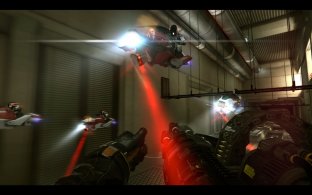

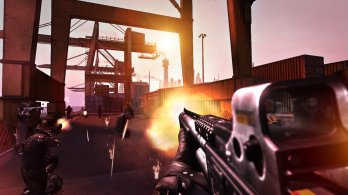

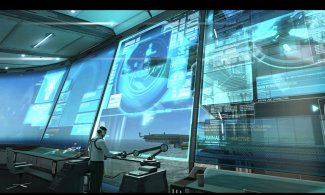

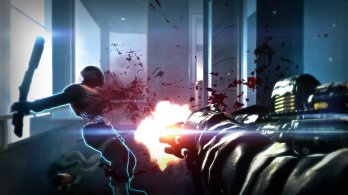
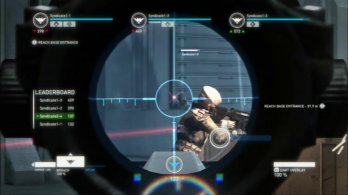
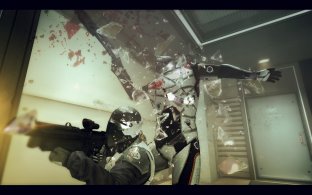
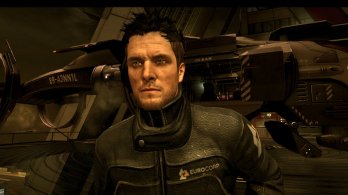
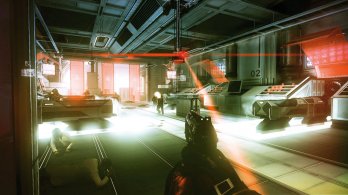


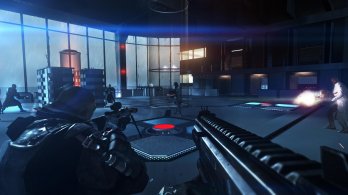
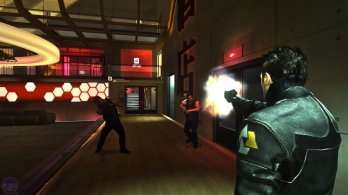

 Buy Now
Buy Now
 Buy Now
Buy Now
 Buy Now
Buy Now
 Buy Now
Buy Now
 Buy Now
Buy Now
 Buy Now
Buy Now















